2025
Department of Local Government, Water and Volunteers (Queensland Government)
UX Research, Digital Strategy, Accessibility Consulting, UI Design, Prototyping
UX Research, Accessibility Consultant, Strategist, UX/UI Designer, Workshop Facilitator
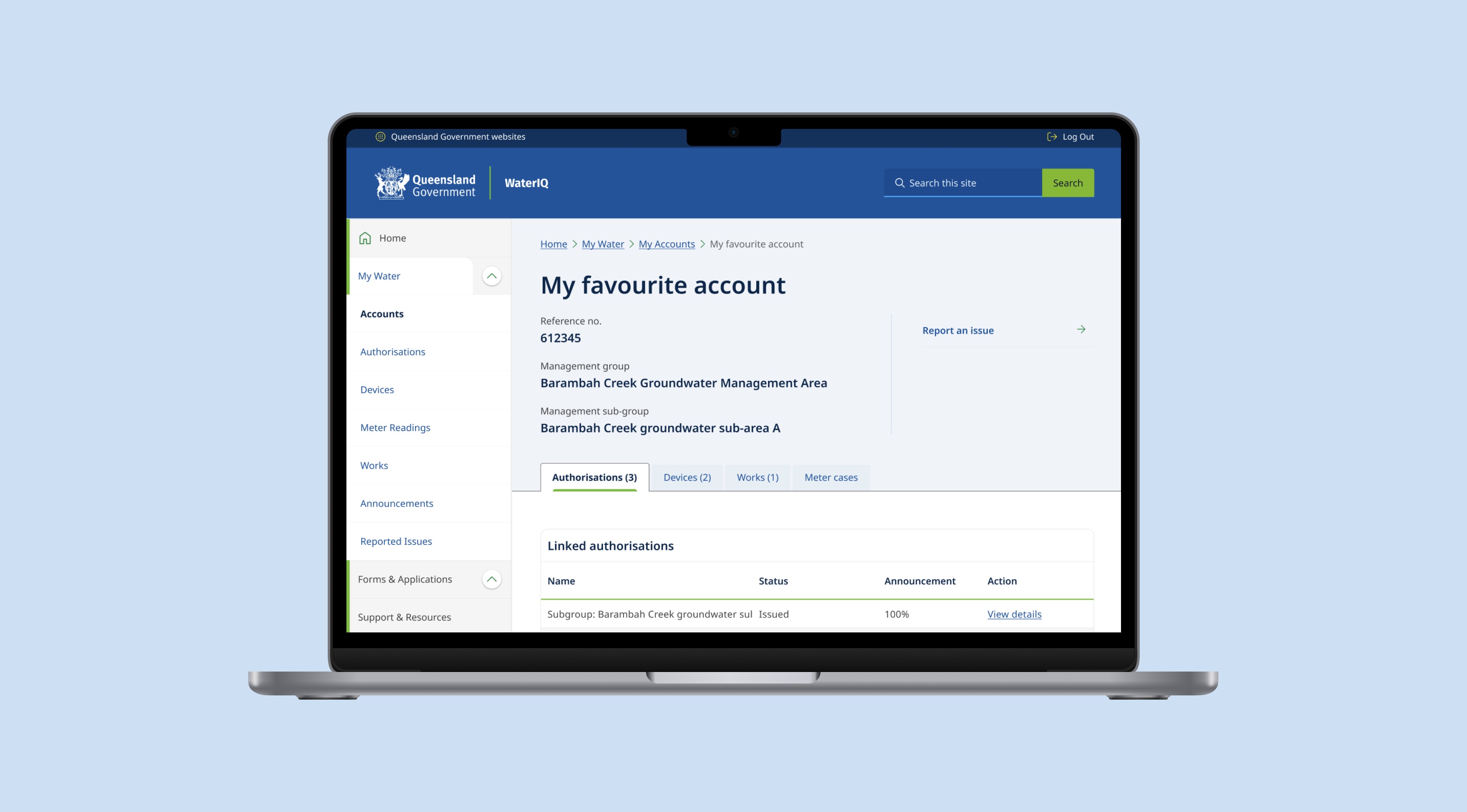
A failing portal was reimagined through accessibility, design, and trust-building.
I ran interviews, facilitated an accessibility workshop, mapped the end-to-end journey, and delivered development-ready prototypes alongside a phased roadmap.
These efforts overturned a previously “untouchable” system policy and started to rebuilt trust with users. By addressing root causes and phasing delivery, WaterIQ is positioned to shift from a compliance burden to a proactive partner on track for 80% digital adoption.
The Queensland Government’s WaterIQ portal was created to help farmers, irrigators, and businesses manage licenses and submit meter readings online. Despite the investment, adoption was critically low. Users overwhelmingly preferred to email a PDF form, perceiving the portal as a compliance burden rather than a useful tool.
Frustration with the system eroded trust and damaged the department’s relationship with the community. The goal was clear: diagnose the root causes of failure and create a path to reach 80% digital adoption.
Horizon 1: Build a usable & accessible foundation
Migration to the Queensland Government Design System (QGDS). Critical WCAG issues resolved. A new “first glance” dashboard designed to provide instant value.
Horizon 2: Compete with the PDF
Delegated and simplified login options designed. Mobile app repositioned as a quick, biometric companion tool.
Horizon 3: Become the preferred partner
Proactive features such as usage trends, alerts, and water trading tools introduced. Portal positioned as a trusted, proactive service rather than a compliance tool.
The project was delivered through a collaborative process that combined research, accessibility review, journey mapping, and co-design.
By working closely with subject matter experts across a complex government structure and engaging directly with water entitlement holders, the team ensured solutions were evidence-based, technically feasible, and grounded in real user needs.
This approach not only identified systemic barriers but also created alignment across stakeholders and gave users confidence that their voices were finally being heard.
User research
17 interviews with 19 participants across Queensland revealed operational bottlenecks, distrust, and unmet needs.
Accessibility audit
A rapid WCAG 2.1 AAA workshop with internal teams surfaced critical barriers, trained developers, and provided executives with tangible evidence for accessibility investment.
Journey mapping
End-to-end experiences were visualised, exposing pain points and broken trust. This revealed the single greatest adoption barrier: login.
Collaborative design
Created alignment in a complex government structure and gave users a direct role in shaping solutions, with many reporting it was the first time their feedback had been genuinely heard.
17 in-depth interviews were conducted with 19 participants across Queensland, including farmers, irrigators, corporate operators, and local government staff.
A theme that came through strongly was that people felt invisible. Many described previous attempts to give feedback as ignored, and for several, this was the first time they felt their voice was genuinely being heard. Creating that space was as important as the insights themselves, as it began rebuilding trust between users and the system.
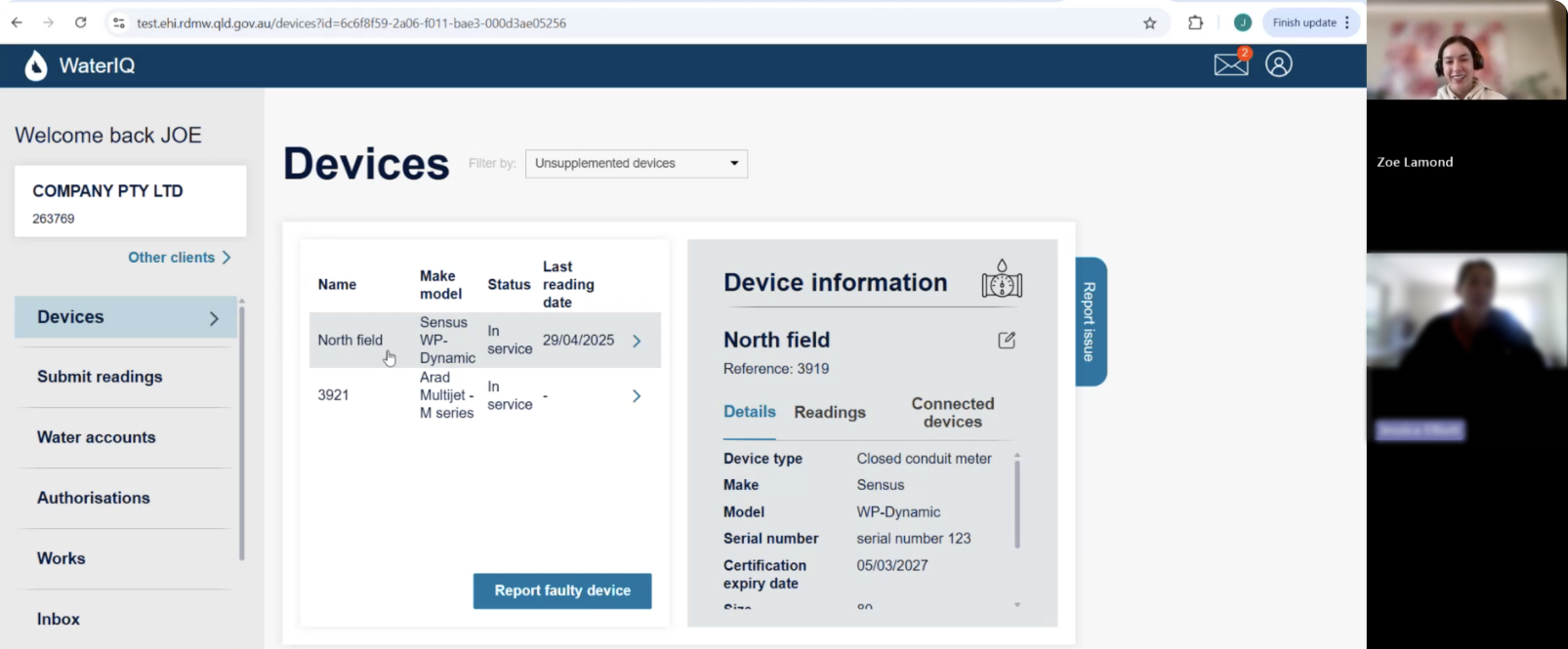
Crippling login friction
The mandated myID authentication was overly complex and tied to a single person, creating operational bottlenecks and making adoption targets unattainable.Greater adoption is dependant on clear, tangible value.
A broken value exchange
The portal asked for time and data but gave nothing back. Without dashboards, insights, or trends, there was little reason for users to engage.
Erosion of trust
With no feedback channels, users felt ignored, describing the portal as the product of “distant rule-makers.”
Misalignment with real-world workflows
The portal was designed around compliance processes, not the daily practices of farmers, irrigators, and local operators. Tasks felt bureaucratic and detached from their actual needs, reinforcing the perception of the portal as a burden rather than a tool.Feeling unseen damages willingness to engage.
Mid-project, leadership shifts meant deliverables had to work harder. Executives needed evidence to secure funding and alignment.
Instead of delivering a lengthy report, a leaner set of outputs was created: A compelling journey map that made pain points undeniable. Concise statistics designed to resonate in executive conversations. This decision ensured the work not only addressed user needs but also landed effectively at the organisational level.
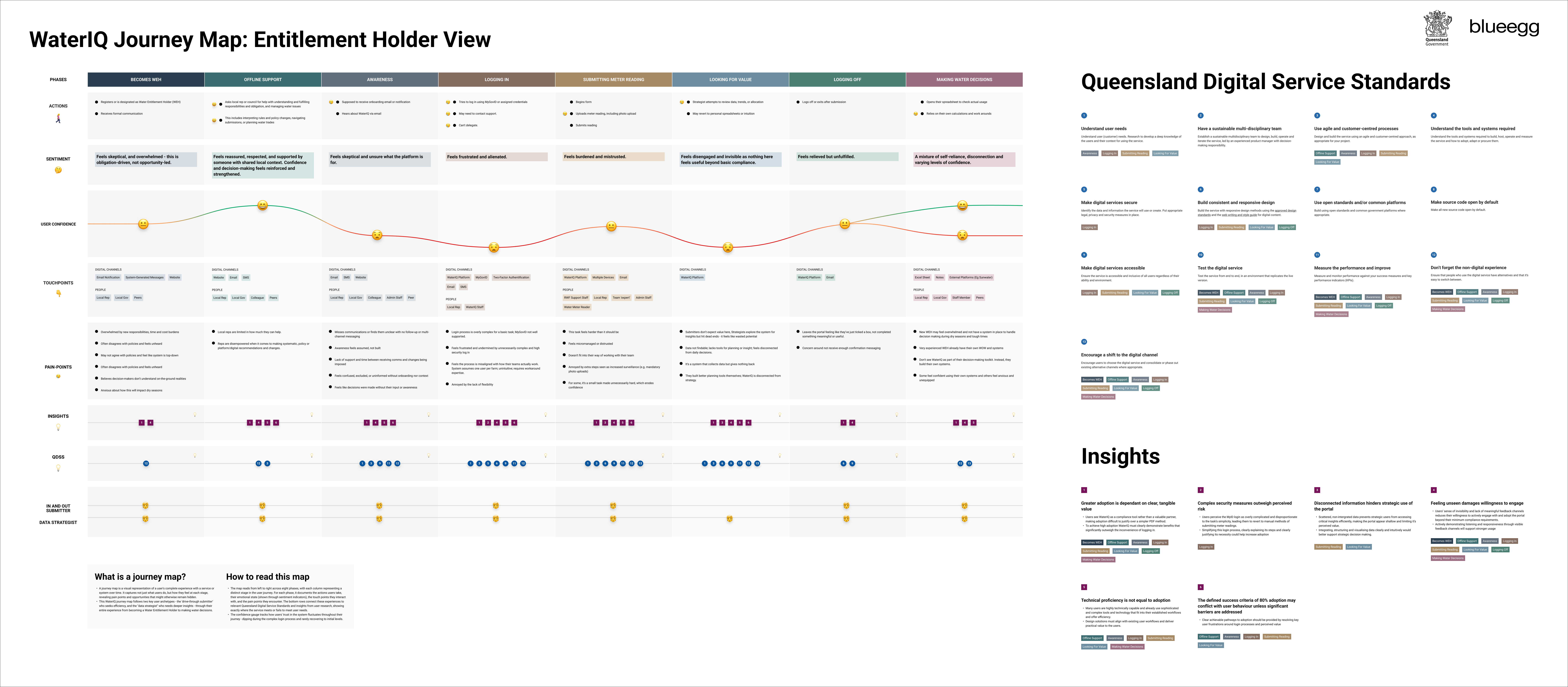
For the first time, executives agreed to revisit the login - opening discussions on delegated and biometric access that had previously been off the table.
Greater adoption is dependant on clear, tangible value
Users see WaterIQ as a compliance tool rather than a valuable partner, making adoption difficult to justify over a simpler PDF method.
Complex security measures outweigh perceived value.
Users perceive the MyID login as overly complicated and disproportionate to the task's simplicity, leading them to revert to manual methods of submitting meter readings.
Disconnected information hinders strategic use of the portal.
Scattered, non-intergrated data prevents strategic users from accessing critical insights efficiently, making the portal appear shallow and limiting its perceived value.
Feeling unseen damages willingness to engage.
A sense of invisibility and lack of meaningful feedback channels reduces their willingness to actively engage with and adopt the portal beyond their minimum compliance requirements.
Technical proficiency is not equal to adoption.
Many users are highly technically capable and already use sophisticated and complex tools for technology that fit into their established workflows and offer efficiency.
The defined success criteria of 80% adoption may conflict with user behaviour unless significant barriers are addressed.
Clear achievable pathways to adoption should be provided by resolving key user frustrations around login processes and perceived value.
Executives wanted confidence that the new system would meet WCAG 2.1 AA standards, while the development team needed practical skills to avoid repeating past mistakes.
At the same time, our client needed to secure executive approval for the rebuild - and accessibility failings provided a powerful way to make the case.
Although the portal was scheduled for a rebuild, accessibility needed to be addressed upfront.
Instead of delivering a long compliance report, I ran a one-day accessibility workshop with internal teams.
The outcome was twofold: executives understood accessibility not as a box-ticking exercise but as a strategic enabler of adoption and risk reduction, while developers gained the confidence to embed accessibility into day-to-day delivery.
The rebuild now has the goal of zero Level A/AA accessibility issues - a significant shift from where the portal began
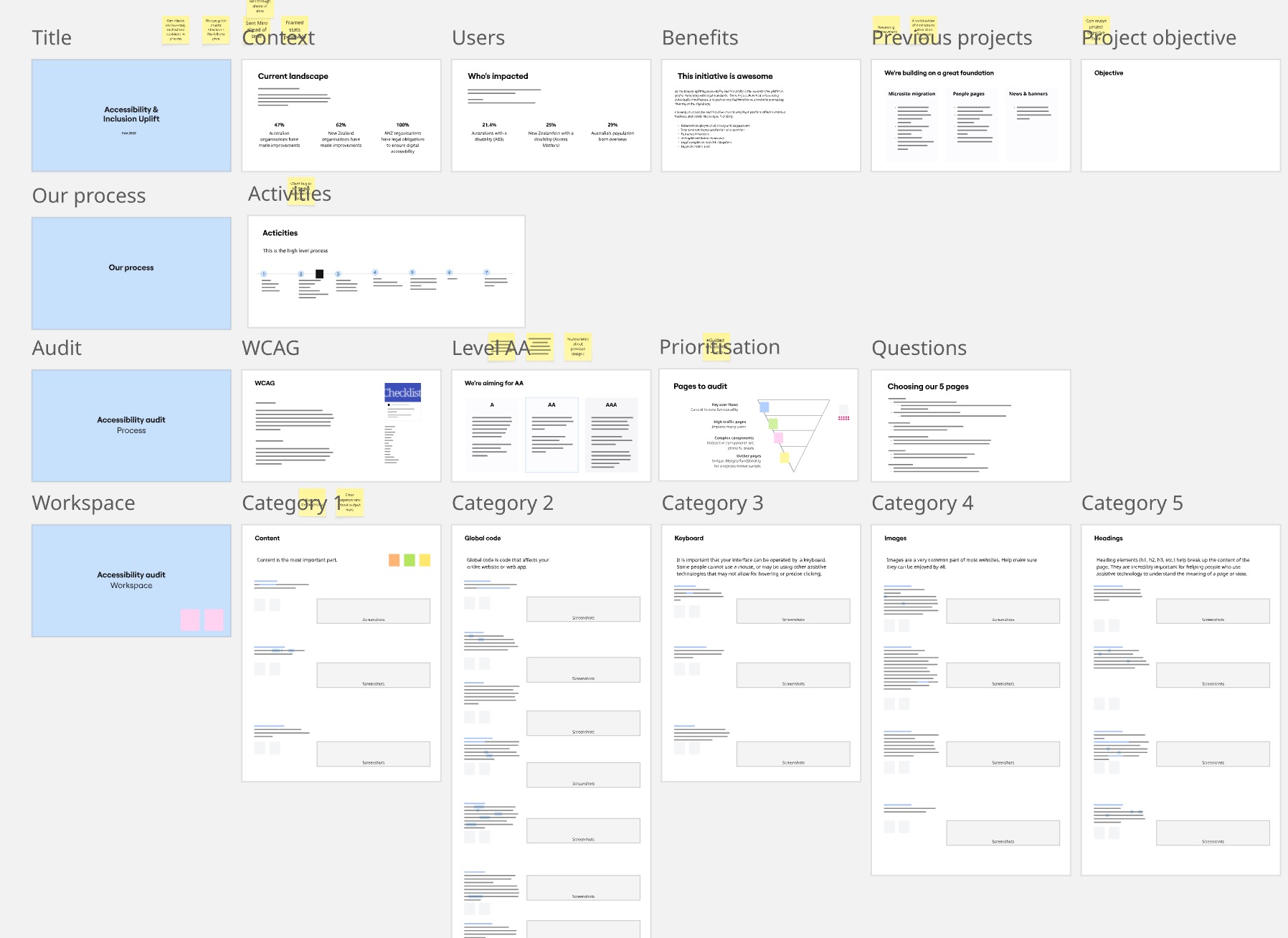
Rapid audit
We reviewed the current portal against WCAG 2.1 AA and surfaced the most pressing barriers - from form field errors and poor keyboard navigation to visual hierarchy and language complexity.
The system scored below 40% compliance, with over 30 critical issues identified across core tasks.
Hands-on training
Developers worked directly with real issues, learning how to diagnose and resolve them.
This built confidence and reduced the risk of accessibility being overlooked in the rebuild.
Strategic evidence for executives
Findings were translated into a set of simple metrics and user impact stories that made the risks impossible to ignore.
By highlighting legal, reputational, and adoption consequences, the workshop gave our client a strong argument to secure investment in the rebuild.
Accessibility embedded in the rebuild
Established accessibility as a foundation for the new design system and rebuild, ensuring issues were prevented rather than retrofitted.
This created a shared standard across teams and a clear goal of zero Level A/AA accessibility issues at launch.
For the initial rebuild, the priority was to create a strong, accessible foundation.
Designs were migrated into the Queensland Government Design System (QGDS) and uplifted to meet WCAG A/AA compliance. I collaborated closely with the QGDS team to refine components, while also reusing proven solutions from other projects to avoid rework and accelerate delivery.
From there, the WaterIQ portal was redesigned for both desktop and mobile, alongside a companion mobile app.
Immediate, meaningful value
Vital information, surfaced right away. Allocation usage trends, core tasks - immediately accessible.
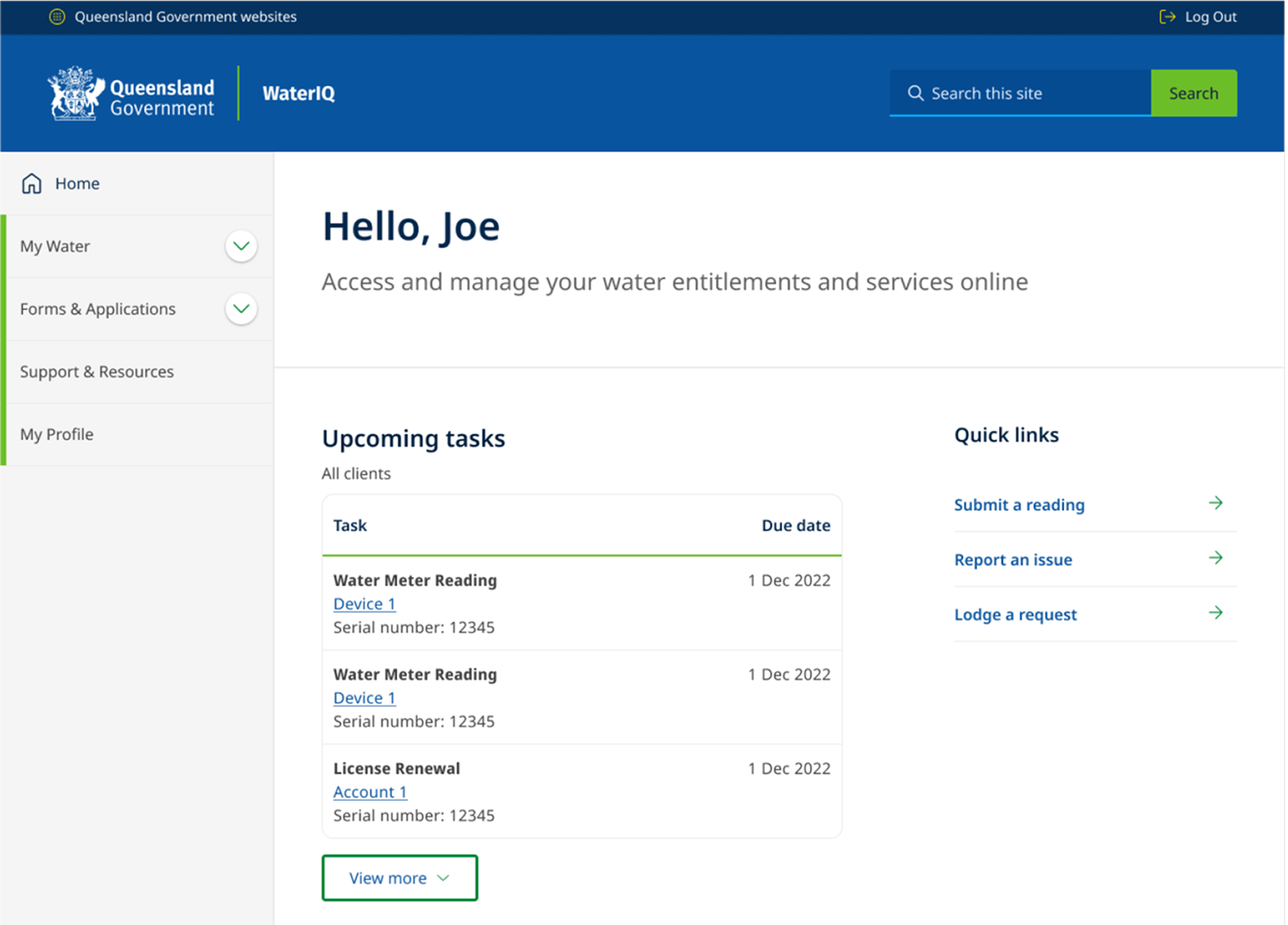
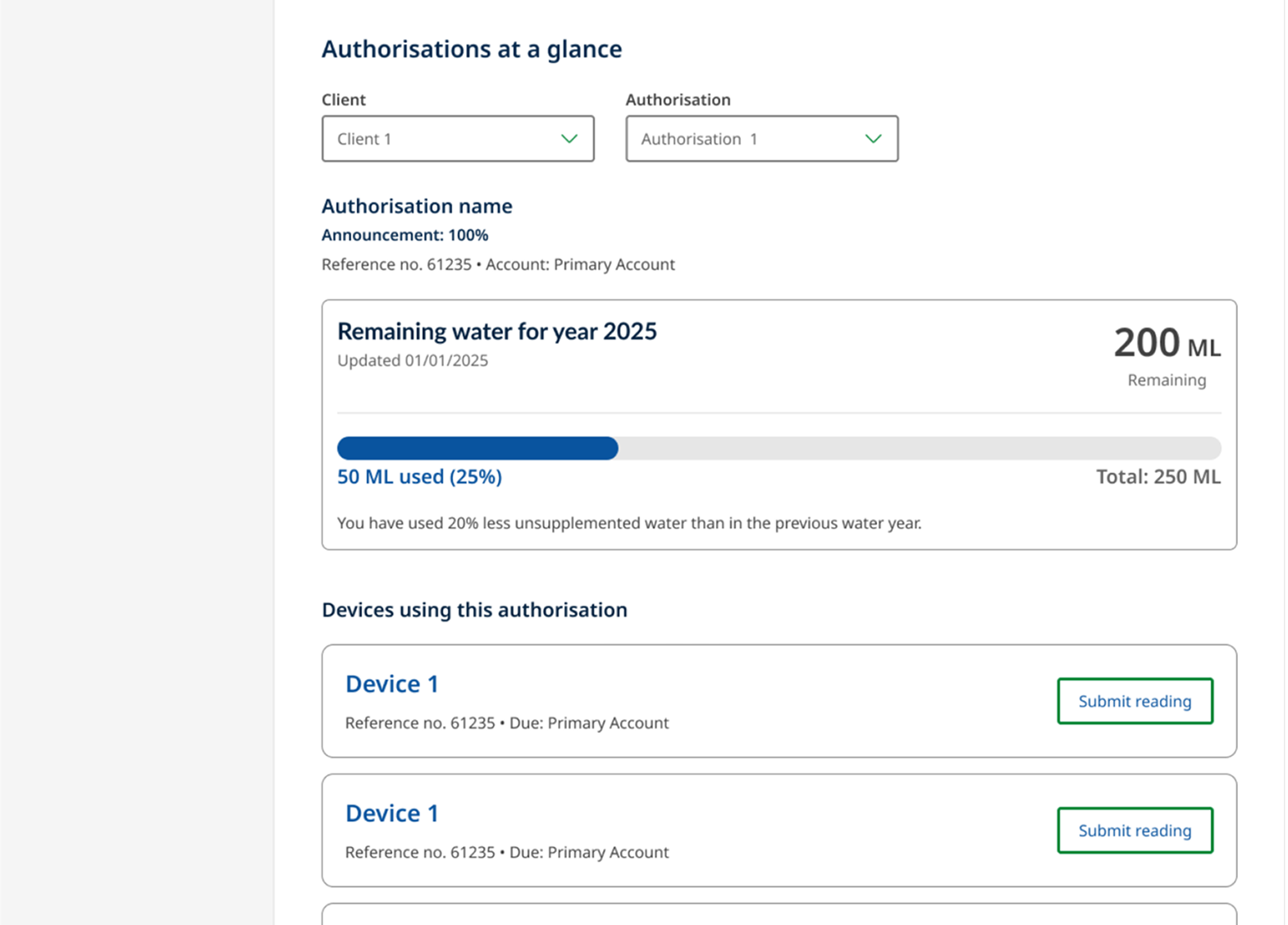
MyID for first login only
Biometrics/pin access for return use
As secure as passwords, but feels effortless
Cut down login time from minutes to seconds
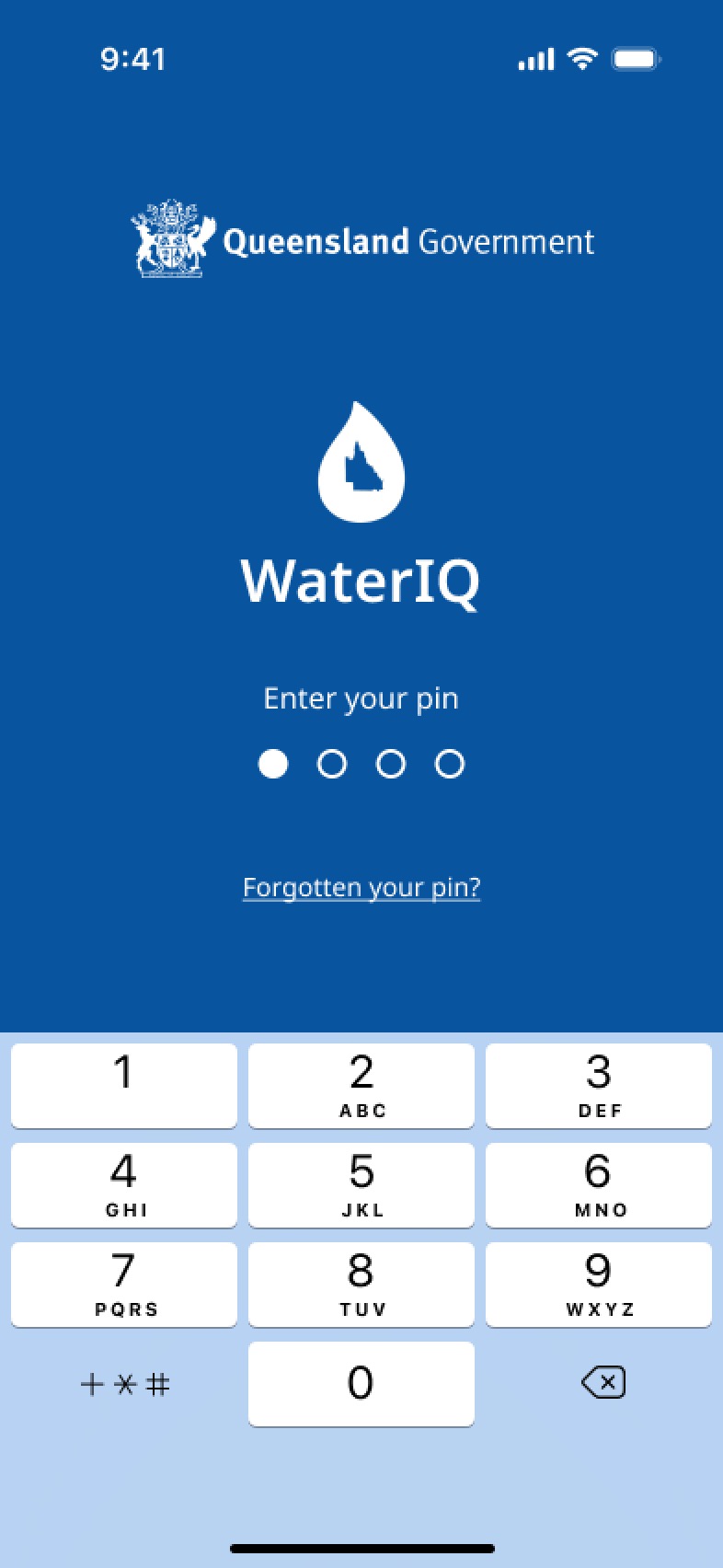
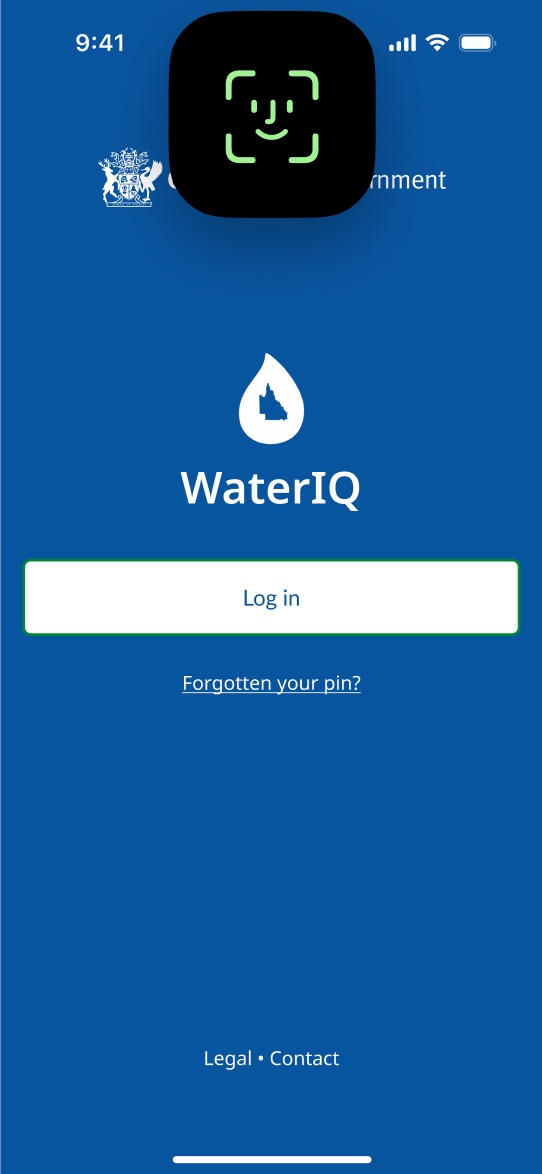
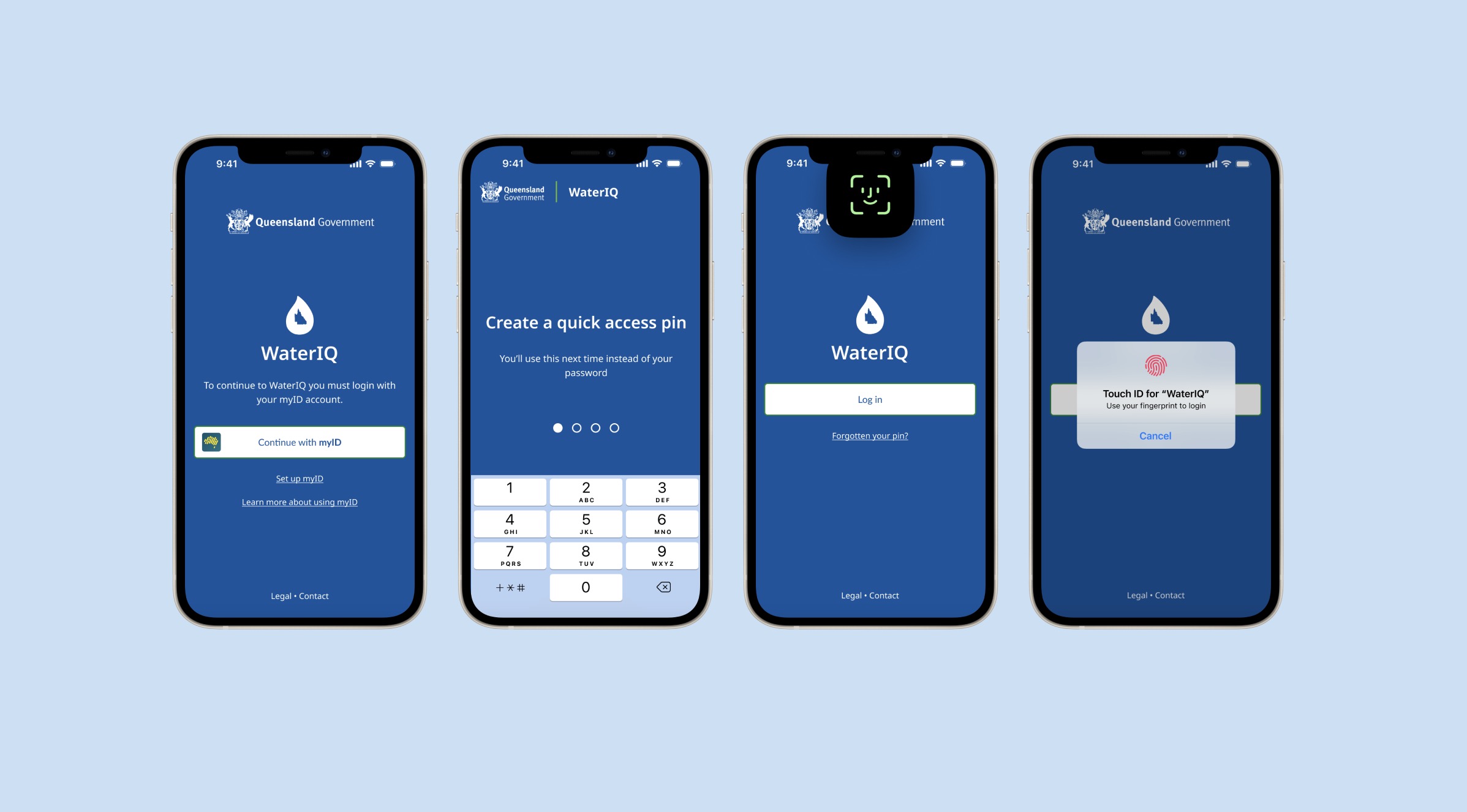
I created low-fidelity concepts and tested them with users to shape recommendations for future improvements in the roadmap.
These concepts explored advanced features such as intelligence, enhanced forms, and workflow improvements that would position WaterIQ as the preferred experience.

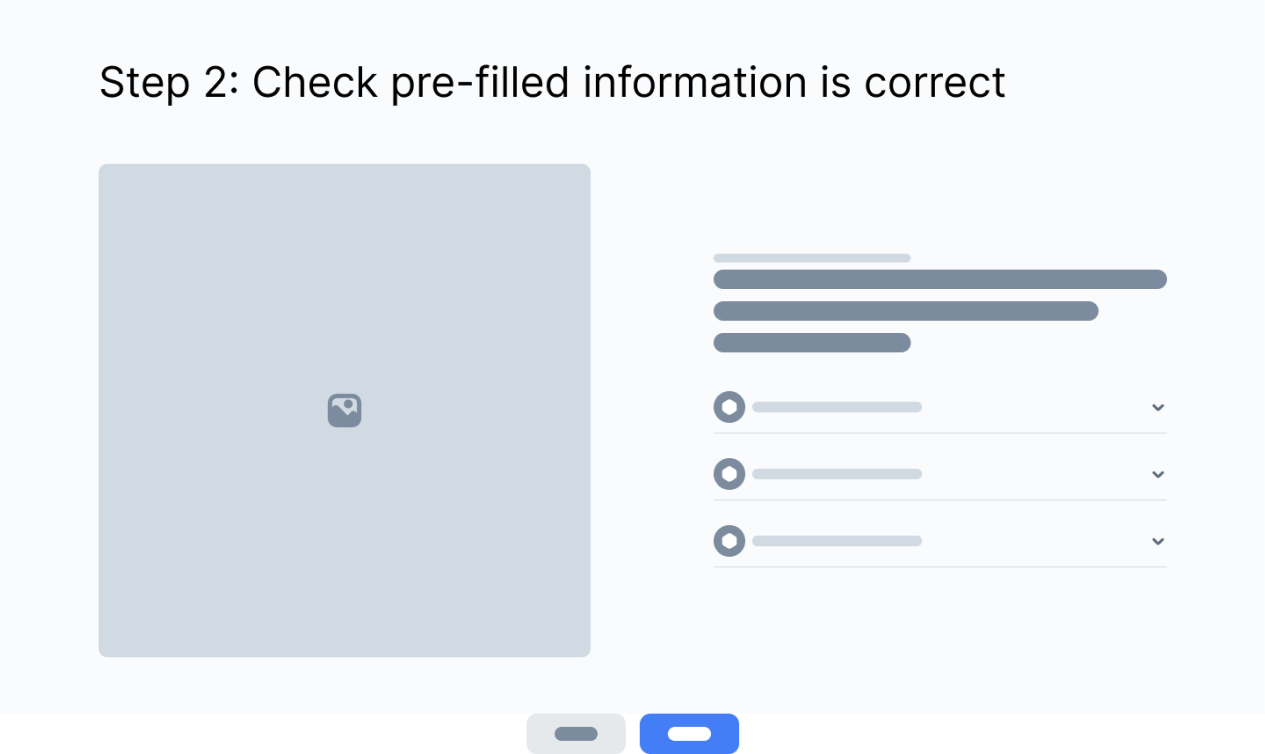
This project pushed me beyond design delivery into shaping policy decisions, executive priorities, and team capability.
Build support can start in Discovery.
Involving developers in the accessibility audit turned discovery into education. By diagnosing and fixing issues hands-on, the team built skills and confidence that will reduce mistakes during the rebuild and set a goal of zero accessibility issues.
Accessibility can unlock investment.
Demonstrating that the portal didn’t even meet basic requirements gave executives a powerful reason to fund the rebuild. Accessibility became more than compliance — it became the lever that unlocked budget during a time of risk aversion and tight funding.
Design artefacts are powerful levers.
A single journey map reframed the login issue from a user complaint into the reason adoption goals couldn’t be met, overturning what had been considered an “untouchable” decision.
Keep checking why deliverables are needed.
Rather than relying only on the initial project brief, I kept asking what the client needed artefacts for. That led me to recommend leaner outputs like a journey map and stats instead of a dense report - materials they could actually use in executive conversations.